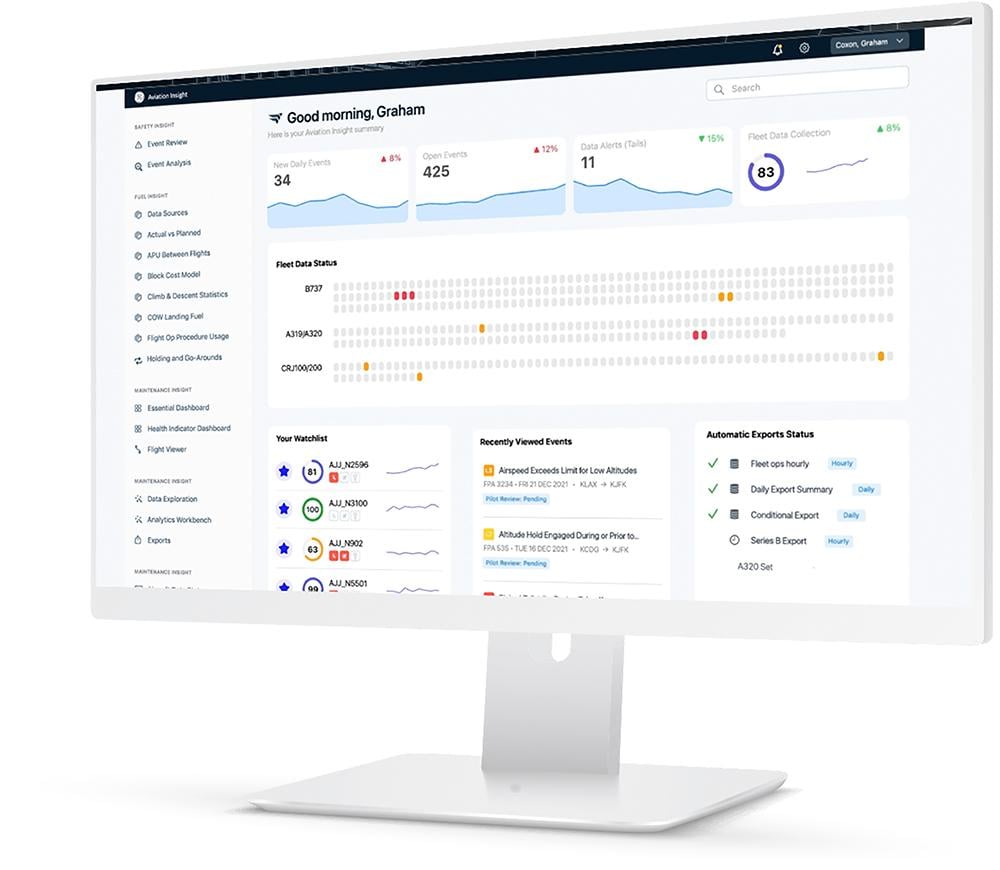
GE Digital has released the first two modules of its Aviation Insight Portal, the next evolution of the vendor’s Event Measurement System (EMS) platform. EMS is a back-office data analysis tool, which has been under continuous development by the San Ramon, California-based company for the past 25 years.
“Our EMS needed to be modernized to fit the needs of our customers and the way they want to interact with their data,” says Luke Bowman, GE Digital’s senior product manager for aviation software. “Aviation Insight Portal allowed us to modernize the functionality of EMS in one, user-friendly portal.”
EMS, explains Bowman, is a comprehensive flight data processing platform, allowing users to integrate many disparate data sources such as weather, navigation, data, flight plans, load sheets and more. He adds that the initial focus of Aviation Insight Portal was flight safety, but that has been extended to predictive maintenance and fuel efficiency. “Those pieces of the EMS platform which will support predictive maintenance are in the process of being moved into the Aviation Insight Portal,” he says.
Bowman says the platform also provides an option for the customer to build their own predictive maintenance solution, or for GE Digital, itself, to build the analytics, targeting any specific systems for maintenance issues tracking.
The two Aviation Insight Portal modules consist of an Event Review module and an Aircraft Data Status module.
The Event Review module was designed for safety analysts to review “peer level” safety events, hear directly from flight crew, and provide suggestions and information to address those safety events in the future. It also allows users to drag flight parameters into groups to automatically populate charts that enable the users to analyze values for each parameter down to the split second of an event. Users can also switch to a flight path view to see where events happened along the trajectory. There is also a mapping view where users can see the airports and runways.
The Aircraft Data Status module, a completely new functionality that wasn’t previously available with EMS, permits users to see all the data coming in from the aircraft and provides alerts when there are issues with the data. This enables safety analysts to triage data flow issues in their fleet to see which aircraft require attention, and to deep dive into the data to remedy other flight safety situations. GE says users can sign up for email notifications to make the module even more responsive to customer needs.
“Each module will serve a different persona. Event Review is for both gatekeepers and safety analysts, and Aircraft Data Status is for safety analysts,” says Bowman. “Aviation Insight Portal’s major capability is providing aircraft data status. What data am I getting, what is the quality of the data, are there any gaps in the data, and do we have the data along with the people and the business processes? This will change the way an operator works to pursue data analytics and data collection—and could result in organizational changes.”
What the Aviation Insight Portal does not change is the way data is captured from the aircraft. In fact, Bowman stresses, it leverages the data that is already coming into the EMS, making it easier for customers to interact with it, and “drive meaningful business out-comes,” based on the insights provided on the portal. “Any data from the aircraft can be a target area for Aviation Insight Portal,” he points out. “We are agnostic as to the type of data captured by the aircraft. It all depends on the use cases we support within the modules, which will decide what data will be available within the Aviation Insight Portal.”
Bowman says the platform will also have additional apps to help customers manage their data. Feature/database and time series data currently hosted in EMS are some examples of datasets that will be available to customers to extract for use with other tools, such as Teradata.
With more data being generated by every new aircraft, Bowman says GE Digital is trying to provide airlines with more information on which to run their operations. “Operators will build analytics to move unscheduled to scheduled maintenance—and prevent AOGs,” he notes.





